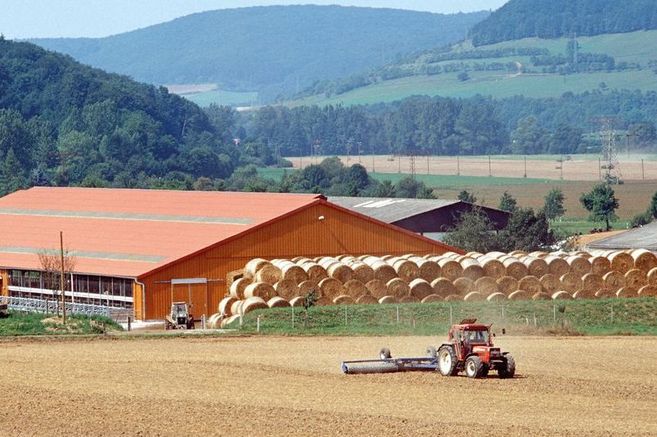Project
Satellite-based Indicators for Monitoring Fen Re-wetting
![[Translate to English:]](/media/_processed_/1/5/csm_2724_Satellitenbasierte-Indikatoren_C-Hellmann_DJI_0076_86976180b4.jpg)
Developing Hyperspectral Indicators for Monitoring Fen Re-wetting
Over 95% of peatlands in Germany have been drained for agricultural and forestry use. Considerable amounts of greenhouse gas emissions can be avoided by rewetting and adapting land use. The project aims to demonstrate the potential of new remote sensing systems for monitoring rewetting measures.
Background and Objective
Agriculturally used peatlands emit around 43 Mio. t CO2 equivalents through the mineralization of organic soils, which accounts for around 5% of total greenhouse gas emissions in Germany. In the 2030 Climate Protection Program and the 2050 Climate Protection Plan, the federal government explicitly names the rewetting of peatlands at the national level as an essential factor in achieving the goal of significant reductions in CO2 emissions. In the agricultural sector in particular, large amounts of emissions can be saved in a relatively small area by rewetting peatlands.
The control of the course of rewetting itself as well as the evaluation of sustainable use concepts (e.g., paludiculture) require regular monitoring. Rewetting of peatland areas leads amongst others to fundamental changes in the vegetation and species composition because of the new, wet situation. The degree of rewetting, the intra-annual fluctuation of water levels and ultimately also the duration since the start of rewetting affect the vegetation and land use. These changes are being investigated in the ReWetSpec project using various sensor systems on different spatial scales (with field, drone, aerial and satellite data). A particular focus is on investigating the potential of hyperspectral satellite data from the EnMAP (Environmental Mapping and Analysis Program) satellite mission for monitoring rewetting.
The aim of the project is to gain a comprehensive understanding of the influence of extensive rewetting measures on the spectral reflection properties of peatland vegetation and the corresponding spatial-temporal reflection gradients. Based on this, a workflow for mapping the occurrence of vegetation types (species or species communities) will be developed. In addition, the potential added value of EnMAP data compared to Copernicus data (Sentinel-1 and 2) for grassland monitoring (see CopGruen project) on fen areas will be evaluated.
Approach
The work focuses on the Peenetal study area near Demmin in Mecklenburg-Western Pomerania and adjacent river valleys with floodplain peatlands. These have been rewetted over different periods of time or are still being drained and used for agriculture. Extensive data sets are already available for these areas, which will be supplemented by our own data collections (by the project partner at the University of Greifswald) over the course of the project. In order to be able to investigate scale influences in detail, spectral information is collected and evaluated both in the field (non-imaging field spectroscopy), with drones, and with various satellite sensors (Sentinel-1, Sentinel-2, EnMAP). In the first step, the relationships between vegetation composition, species diversity and spectral diversity are investigated and approaches to quantifying the occurrence of vegetation types and their changes over time are tested. In the second step, the results will be combined with existing grassland monitoring services in order to evaluate potential synergies between different sensor systems.
Data and Methods
Together with the project partner University of Greifswald, extensive data are collected during the growing season at various scales, from the leaf/plant level to the regional level:
- Vegetation mapping for information on species composition
- Non-imaging field spectroscopy, from plant components to pure species to species communities
- Monthly UAV flights with multi-/hyperspectral sensors
- Multi-temporal hyperspectral satellite data (EnMAP)
- Radar (Sentinel-1) and optical, multispectral (Sentinel-2) satellite data
Our Research Questions
What relationships exist between reflection properties and different vegetation types on rewetted fen areas?
What is the added value of hyperspectral satellite data compared to operationally available Copernicus data (Sentinel-1/-2) for the description and quantification of vegetation and land use in fens?
What spatial-temporal gradients of fen use and rewetting can be identified?
Links and Downloads
Universität Greifswald
- Prof. Dr. Sebastian van der Linden (PI)
geo.uni-greifswald.de/lehrstuehle/geographie/fernerkundung-gi/intro/team/sebastian-van-der-linden/
Thünen-Contact

Involved Thünen-Partners
Involved external Thünen-Partners
- Universität Greifswald
(Greifswald, Deutschland)
Funding Body
-
German Aerospace Center (DLR)
(national, öffentlich)
Duration
10.2022 - 9.2025
More Information
Project funding number: 50EE2234B
Project status:
ongoing







